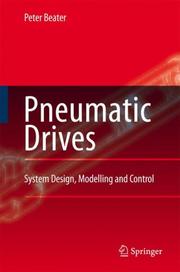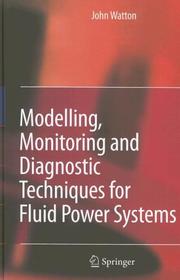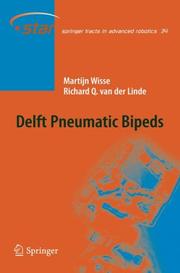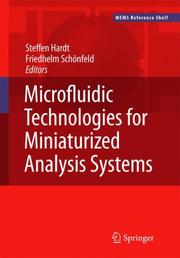| Listing 1 - 4 of 4 |
Sort by
|

ISBN: 1280804025 9786610804023 3540694714 3540694706 3642089003 Year: 2007 Publisher: Berlin ; London : Springer,
Abstract | Keywords | Export | Availability | Bookmark
 Loading...
Loading...Choose an application
- Reference Manager
- EndNote
- RefWorks (Direct export to RefWorks)
This book is a comprehensive work on all aspects of pneumatic drives. It bridges the gap between classical descriptions of pneumatic systems in terms of their steady-state behaviour and the wish of design engineers to test their design before setting up the actual hardware. The book covers the whole range of today’s technology for pneumatic drives. Starting with a wide selection of linear actuators – among them standard and rodless cylinders, bellows and diaphragm cylinders –, semi-rotatory drives and air motors are described in detail. Standard directional control valves, analogue valves as well as pressure control valves are covered, including their design, application and modelling. Several control schemes and the necessary converters like solenoids or piezoelectric actuators are presented. In addition to drives for factory automation and automotive applications the technology for the process industry like positioners or spring-and-diaphragm actuators is described. The wish to analyse the design beforehand requires a mathematical description for computer simulation. Therefore, the book presents the basic laws of nature as well as the design and the modes of operation of pneumatic components to derive the modelling equations. It further covers several control strategies like binary mode cylinder drives or position controlled drives and computer aided analysis of complex systems. The book is a unique resource and valuable reference for both, scientists and graduate students as well as professional engineers who need to design and control pneumatic drives.
Pneumatic machinery --- Fluid power technology. --- Design and construction. --- Fluid power technology --- Machinery --- Fluid mechanics --- Hydraulic engineering. --- Engineering. --- Engineering design. --- Engineering Fluid Dynamics. --- Machinery and Machine Elements. --- Control, Robotics, Mechatronics. --- Engineering Design. --- Design, Engineering --- Engineering --- Industrial design --- Strains and stresses --- Construction --- Industrial arts --- Technology --- Engineering, Hydraulic --- Hydraulics --- Shore protection --- Design --- Fluid mechanics. --- Machinery. --- Control engineering. --- Robotics. --- Mechatronics. --- Mechanical engineering --- Microelectronics --- Microelectromechanical systems --- Automation --- Machine theory --- Control engineering --- Control equipment --- Control theory --- Engineering instruments --- Programmable controllers --- Machines --- Manufactures --- Power (Mechanics) --- Motors --- Power transmission --- Hydromechanics --- Continuum mechanics --- Curious devices

ISBN: 1846283744 1846283736 1849965919 Year: 2007 Publisher: London : Springer,
Abstract | Keywords | Export | Availability | Bookmark
 Loading...
Loading...Choose an application
- Reference Manager
- EndNote
- RefWorks (Direct export to RefWorks)
Today, fluid power systems, hydraulic and pneumatic, in alliance with advanced electronics, provide the world with an unprecedented array of applications and systems from heavy-lifting equipment to spray painting, injection moulding, motion control and product assembly. In common with other facets of modern industrial operation, fluid power systems must be examined with a view to obtaining: • the highest product quality; • optimised efficiency; • improved safety; • maximum profitability. Modelling, Monitoring and Diagnostic Techniques for Fluid Power Systems covers the background theory of fluid power and indicates the range of concepts necessary for a modern approach to condition monitoring and fault diagnosis in a readable and understandable fashion. The theory is constantly leavened by 15 years' worth of practical measurements by the author, working in association with major fluid power companies, and real industrial case studies – hot-strip-mill monitoring in conjunction with Corus p.l.c. being just one example. Comprising four parts, it provides: • an introduction to component behaviour; • a guide to the modelling methods employed for circuit analysis; • methods for doing condition monitoring; • common faults and breakdowns. Modelling, Monitoring and Diagnostic Techniques for Fluid Power Systems gives the first integrated exposition of the fluid power applications of many of the techniques it describes: time-encoded signal processing; artificial neural networks and expert systems among others. Advantages and limitations of the different paths are presented to emphasise that the reader should consider the gamut of methods leading to positive decision-making regarding fault diagnosis. The comprehensive reference for its subject, this book tells practising fluid power engineers all they need to know about keeping track of the "health" of their equipment, processes and products. With nearly four hundred references to provide a good overview of the subject and to stimulate further research, this reference will also be invaluable to graduate and senior undergraduate students entering the field.
Fluid power technology --- Fluid power technology. --- Machinery --- Mathematical models. --- Monitoring. --- Condition monitoring of machinery --- Monitoring of machinery --- Nondestructive testing --- Fluid mechanics --- Engineering. --- Manufactures. --- Hydraulic engineering. --- Mechanical engineering. --- Artificial intelligence. --- Machinery and Machine Elements. --- Control, Robotics, Mechatronics. --- Manufacturing, Machines, Tools, Processes. --- Engineering Fluid Dynamics. --- Mechanical Engineering. --- Artificial Intelligence. --- AI (Artificial intelligence) --- Artificial thinking --- Electronic brains --- Intellectronics --- Intelligence, Artificial --- Intelligent machines --- Machine intelligence --- Thinking, Artificial --- Bionics --- Cognitive science --- Digital computer simulation --- Electronic data processing --- Logic machines --- Machine theory --- Self-organizing systems --- Simulation methods --- Fifth generation computers --- Neural computers --- Engineering, Mechanical --- Engineering --- Steam engineering --- Engineering, Hydraulic --- Hydraulics --- Shore protection --- Manufactured goods --- Manufactured products --- Products --- Products, Manufactured --- Commercial products --- Manufacturing industries --- Construction --- Industrial arts --- Technology --- Machinery. --- Control engineering. --- Robotics. --- Mechatronics. --- Fluid mechanics. --- Hydromechanics --- Continuum mechanics --- Mechanical engineering --- Microelectronics --- Microelectromechanical systems --- Automation --- Control engineering --- Control equipment --- Control theory --- Engineering instruments --- Programmable controllers --- Machines --- Manufactures --- Power (Mechanics) --- Motors --- Power transmission --- Curious devices

ISBN: 9783540728078 3540728074 9786610969890 128096989X 3540728082 Year: 2007 Publisher: Berlin, Germany ; New York, New York : Springer,
Abstract | Keywords | Export | Availability | Bookmark
 Loading...
Loading...Choose an application
- Reference Manager
- EndNote
- RefWorks (Direct export to RefWorks)
Walking is simple for most of us, but two-legged robots (bipeds) are often slow, complex, inefficient, heavy, and have robotic-looking motions. What makes human walking so graceful? Can this be replicated with human-like robots? Martijn Wisse and Richard Q. van der Linde provide a detailed description of their research on pneumatic biped robots at the Delft University of Technology, The Netherlands. The book covers the basic theory - passive dynamic walking - and explains the implementation of pneumatic McKibben muscles in a series of successful prototypes.
Mobile robots. --- Robots --- Bipedalism. --- Pneumatic machinery. --- Robots mobiles --- Motion. --- Mouvements --- Robots -- Motion. --- Mobile robots --- Bipedalism --- Pneumatic machinery --- Mechanical Engineering --- Engineering & Applied Sciences --- Mechanical Engineering - General --- Motion --- Information Technology --- Artificial Intelligence --- Bipedal locomotion --- Bipedal posture --- Bipedal walking --- Bipedality --- Bipedalization --- Posture, Bipedal --- Upright walking --- Walking, Bipedal --- Walking, Upright --- Movement of robots --- Robot motion --- Engineering. --- Artificial intelligence. --- System theory. --- Control engineering. --- Robotics. --- Mechatronics. --- Control, Robotics, Mechatronics. --- Artificial Intelligence (incl. Robotics). --- Systems Theory, Control. --- Mechanical engineering --- Microelectronics --- Microelectromechanical systems --- Automation --- Machine theory --- Control engineering --- Control equipment --- Control theory --- Engineering instruments --- Programmable controllers --- Systems, Theory of --- Systems science --- Science --- AI (Artificial intelligence) --- Artificial thinking --- Electronic brains --- Intellectronics --- Intelligence, Artificial --- Intelligent machines --- Machine intelligence --- Thinking, Artificial --- Bionics --- Cognitive science --- Digital computer simulation --- Electronic data processing --- Logic machines --- Self-organizing systems --- Simulation methods --- Fifth generation computers --- Neural computers --- Construction --- Industrial arts --- Technology --- Philosophy --- Fluid power technology --- Machinery --- Human beings --- Locomotion --- Attitude and movement --- Systems theory. --- Artificial Intelligence.

ISBN: 1281337242 9786611337247 0387684247 0387285970 1441939482 Year: 2007 Publisher: New York : Springer Science+Business Media, LLC,
Abstract | Keywords | Export | Availability | Bookmark
 Loading...
Loading...Choose an application
- Reference Manager
- EndNote
- RefWorks (Direct export to RefWorks)
Microfluidic Technologies for Miniaturized Analysis Systems provides a comprehensive overview of the fluidic aspects of Lab-on-a-Chip technology. This book describes the most important and state-of-the-art microfluidic technologies and the underlying principles utilized in the implementation of fluidic protocols of miniaturized analysis systems. This book discusses many of the effects, outcomes, and techniques which are unique to microfluidic systems. The specific components of this technology toolbox are elucidated through research and examples presented by some of the most renowned experts in the field. Microfluidic Technologies for Miniaturized Analysis Systems is an important reference for professionals and academic researchers seeking information about the latest techniques, including: Control and pumping of small amounts of liquid Particle and cell manipulation Micromixing Separation technology Bioanalytic methods About the MEMS Reference Shelf: The MEMS Reference Shelf is a series devoted to Micro-Electro-Mechanical Systems (MEMS), which combine mechanical, optical, or fluidic elements on a common microfabricated substrate to create sensors, actuators, and microsystems. This series strives to provide a framework where basic principles, known methodologies, and new applications are integrated in a coherent and consistent manner. STEPHEN D. SENTURIA, MASSACHUSETTS INSTITUTE OF TECHNOLOGY, PROFESSOR OF ELECTRICAL ENGINEERING, EMERITUS.
Biochips. --- Fluidic devices. --- Microelectromechanical systems. --- Microfluidics. --- Micromechanics. --- Composite materials --- Solid state physics --- Microstructure --- Fluidics --- Nanofluids --- MEMS (Microelectromechanical systems) --- Micro-electro-mechanical systems --- Micro-machinery --- Microelectromechanical devices --- Micromachinery --- Micromachines --- Micromechanical devices --- Micromechanical systems --- Electromechanical devices --- Microtechnology --- Mechatronics --- Fluid power technology --- Bioreactors --- Molecular computers --- Combinatorial chemistry --- Hydraulic engineering. --- Engineering. --- Biomedical engineering. --- Electronics. --- Engineering Fluid Dynamics. --- Nanotechnology and Microengineering. --- Biomedical Engineering and Bioengineering. --- Biological and Medical Physics, Biophysics. --- Soft and Granular Matter, Complex Fluids and Microfluidics. --- Electronics and Microelectronics, Instrumentation. --- Electrical engineering --- Physical sciences --- Clinical engineering --- Medical engineering --- Bioengineering --- Biophysics --- Engineering --- Medicine --- Construction --- Industrial arts --- Technology --- Engineering, Hydraulic --- Fluid mechanics --- Hydraulics --- Shore protection --- Fluid mechanics. --- Nanotechnology. --- Biophysics. --- Biological physics. --- Amorphous substances. --- Complex fluids. --- Microelectronics. --- Microminiature electronic equipment --- Microminiaturization (Electronics) --- Electronics --- Semiconductors --- Miniature electronic equipment --- Complex liquids --- Fluids, Complex --- Amorphous substances --- Liquids --- Soft condensed matter --- Biological physics --- Biology --- Medical sciences --- Physics --- Molecular technology --- Nanoscale technology --- High technology --- Hydromechanics --- Continuum mechanics
| Listing 1 - 4 of 4 |
Sort by
|

 Search
Search Feedback
Feedback About UniCat
About UniCat  Help
Help News
News